
A Final Word on the Baja Ha-Ha
We wanted to say one last word about the 26th Baja Ha-Ha, and to share a few unpublished photos and anecdotes.
We would again like to thank Latitude 38 founder and Grand Poobah of the Baja Ha-Ha, Richard Spindler, for penning this year’s recap of the 26th cruiser’s rally from San Diego to Cabo San Lucas. This final(-ish) recap marks a kind of passing of the torch. (There have been many such moments in the last few years here at Latitude). With any luck, we hope to send our newest editor on next year’s 27th Ha-Ha and report on the event from the perspective of a first-timer. With that said, we also wanted to prepare the West Coast cruising world for the upcoming Ha-Ha XXVII.
“So soon?” you might ask. Well, one thing we’ve learned is that you can never plan soon enough.
Also, we grabbed many photos from the Baja Ha-Ha website, and from social media. If we have published a photo of yours that is not properly credited, or if you’d like to add a few details to said photo, then please let us know!
The Last Words
— “We had great sailing this year, and it was wonderful to meet everyone. An incredible event.” Kevin Millett, who is on his third Ha-Ha, and new wife Katy.
— “Man o’ War Cove was great. Maybe one less day at BSM.” Mark and Linda LeVander, I’O, Davidson 44.
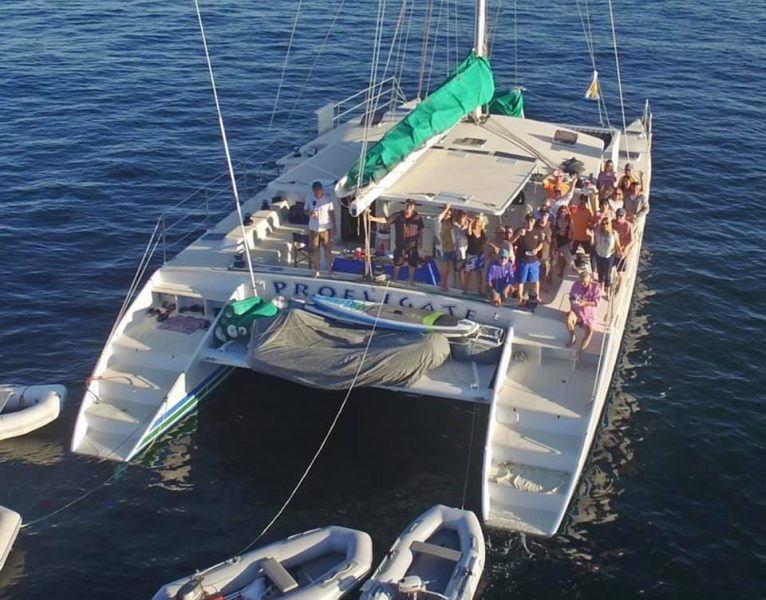
— “Sailed both first legs and nipped 50-foot cat for line honors in the first leg. It was crew Wayne Harvey’s first time sailing offshore at night. But we had Jay Crum of Santa Cruz, too, professional sailor and great guy. Went offshore on both legs, second one 100 miles offshore. Wahoo sushi, seared ahi, but missed a good size dorado. Another great Ha-Ha, thank you so much.” Robert Day, Day Dream, J/122.

Here are some of the Poobah’s notes:
— There was some towing. Kurt Christofferson’s Deerfoot Emma, a vet of five Ha-Ha’s, towed Baron Weller and Heather Kahler’s Aries 32 Sans Souci most if not all of the way to Cabo.
— Somehow Betsy Ash and Warren Swopes’ Beneteau 423 Cyan and Robert Blackwood’s schooner Force Majeure had a major bow-to-beam collision at night in the wide entrance to Mag Bay. The collision was so violent that one Cyan crewmember later peed a little blood. Both skippers agree on who was at fault — the other guy.
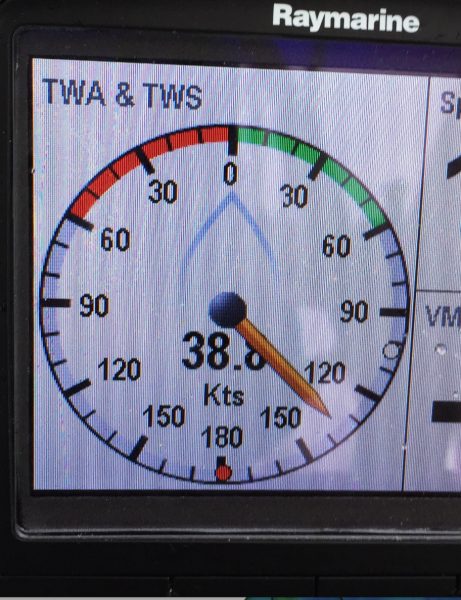
— After the fleet arrived at 240-mile-distant Bahia Santa Maria, one boat reported having seen 44 knots of wind, while others told stories of wind in the high 30s. Having never seen such winds on the Ha-Ha course in 25 years, the Poobah was just a tiny bit skeptical. But Daniel Casey of the Jeanneau 469 Shanti had a photo of his instruments showing 38 knots. The Poobah became an embarrassed believer instead of a doubter.
— With the approach of the depression [the remnants of Tropical Storm Raymond], the Cabo San Lucas Marina staff worked hard to squeeze every boat possible into the marina. Darin, Chewy, and Guiti worked tirelessly, assisted by all the boat owners. Chewy literally gave the shirt off his back. For when one of the Ha-Ha women admired the IGY Marina shirt he was wearing, which hasn’t been made in years, Chewy took it off his back and handed it to her.
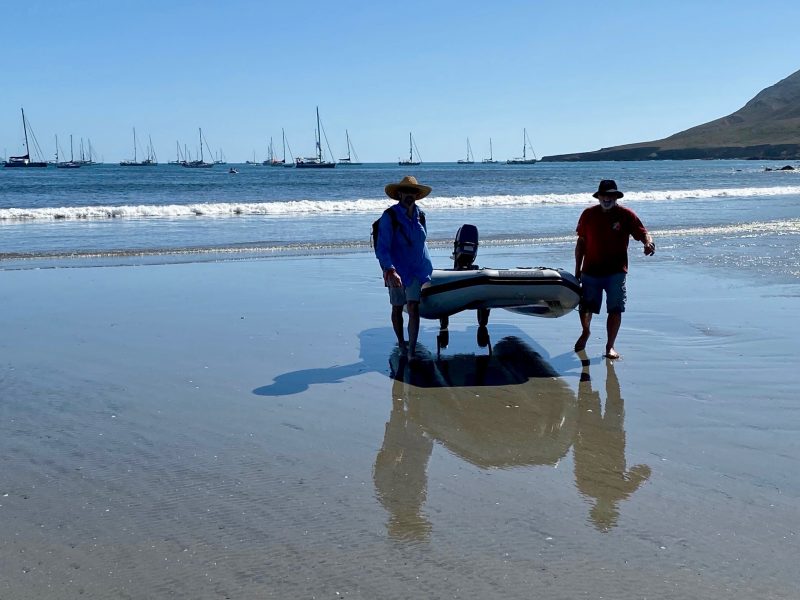
— The tentative dates for Baja Ha-Ha 27 are November 2-14. Don’t miss it!
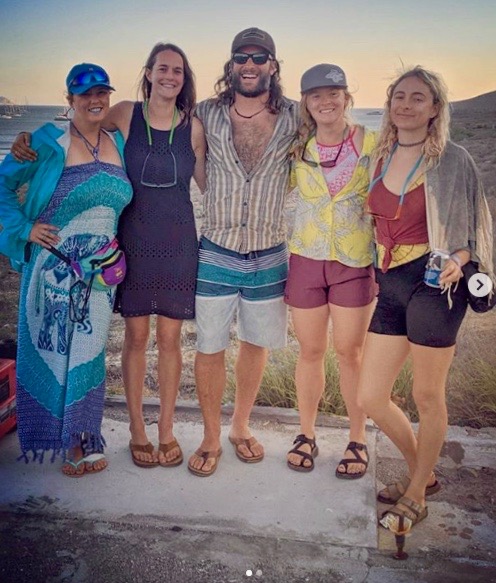
— In the ‘old days’, such as the first race the Poobah did to La Paz in 1981, or even the first Ha-Ha in 1994, things were so much easier from a management standpoint. The fleet was given a two-day weather report before the start, and wished the best of luck, and sent along their way. There were no additional weather reports, no daily position reports, no two-way communication, no contact with the outside world. It was so easy. It’s monumentally more work now.
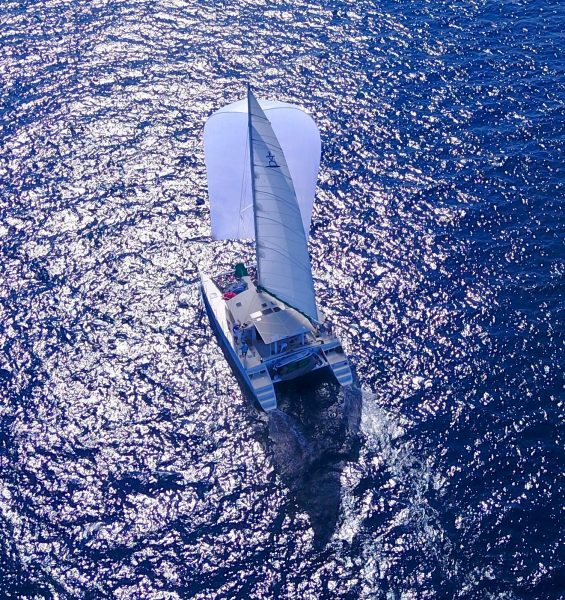
— The Assistant Poobah Patsy Verhoeven responded to literally thousands of emails before the event, and responded to thousands of InReach messages during the event. The Poobah couldn’t have done the Ha-Ha without her. Nor could the Poobah have done it without all the other behind-the-scenes work done by Doña de Mallorca, Chief of Security. A huge thanks also goes out to the crew of Profligate: Dino, Chris, Sabra, Gordon, Edwin, Christopher, Lynn, Mia, Doña, and certainly not least of all, Scott. Mind you, nobody is looking for even an ounce of sympathy. [We] all love putting on the Ha-Ha. Absolutely love it! It allows us to enjoy our Golden Years right now.
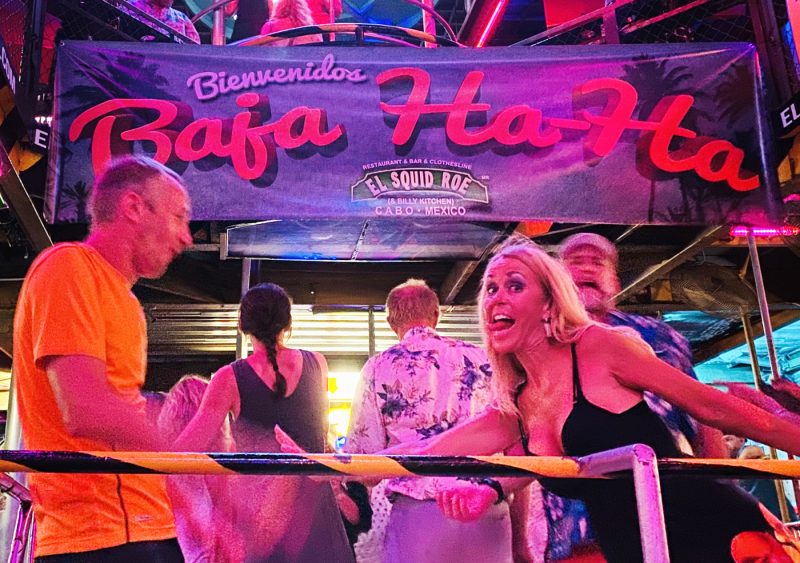
Do You Want to Do the Baja Ha-Ha Next Year?
We assume that prospective Ha-Ha-ers fall into two categories: those who have their own boats, and those who are looking to crew. If you’re in category one, then the decision to go will involve the relationship with your job, your finances, etc. We can’t give much advice here, but there are plenty of stories about cruisers who thought it would be impossible and found a way.
As for those looking for a boat to crew on, our advice is simple, but pointed: Start looking now. We were shocked to find that a great many boats were already booked for this year’s rally as of March 2019. Some skippers told us that they get requests to crew “years in advance.”
We will take a break from all things Ha-Ha for the next few months, but will bring you news of the 2020 Baja Ha-Ha XXVII signups in the spring. Stay tuned, or check www.baja-haha.com for updates.
Adventures on the High Seas in Maxi-Trimarans
Jules Verne Trophy
As this article is posted, the 132-ft maxi-trimaran Spindrift 2 is less than 24 hours into its fourth attempt at tackling the Trophée Jules Verne record for the fastest boat to sail around the globe. It’s a lofty record that now stands at an incredible 40 days 23 hours 30 minutes. The world’s largest offshore multihull must be back to the finish line off northwestern France by 8 p.m. on January 13 to be successful in her attempt. The boat, formerly known as Banque Populaire V, set the record of 45 days in 2012. She still holds the fastest 24-hour run of all time, having sailed some 908 miles in one day while crossing the Atlantic way back in 2009.
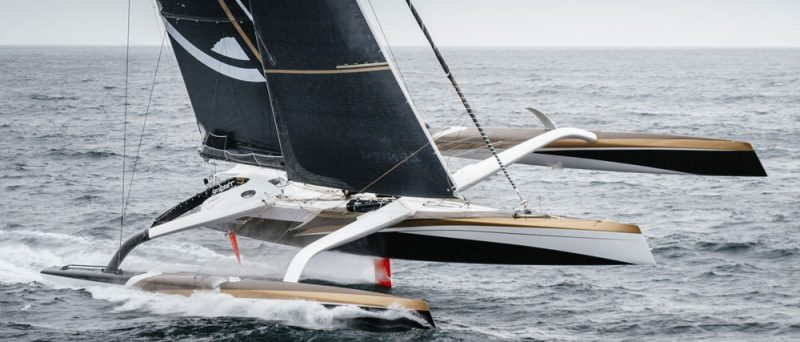
As for their record attempt this time around, skipper Yann Guichard and his crew of 11 aren’t off to a record-setting start, having sailed into light winds across the Bay of Biscay before reaching the stronger northerly breeze associated with the Portuguese Trades. Furthermore, she appears to be sailing directly through the Traffic Separation Scheme off Cape Finisterre as this article is being written. While we won’t claim to be experts on this matter, we do recall several notable incidents in which boats were either protested or fined for very similar infractions. Given the deep pockets of the Bertarelli family, which owns Spindrift 2, we can only speculate that the team is very well aware of their infraction and potential legal fees and simply does not care, as they are attempting to set a record. They can certainly afford any legal fees and fines that may come their way.
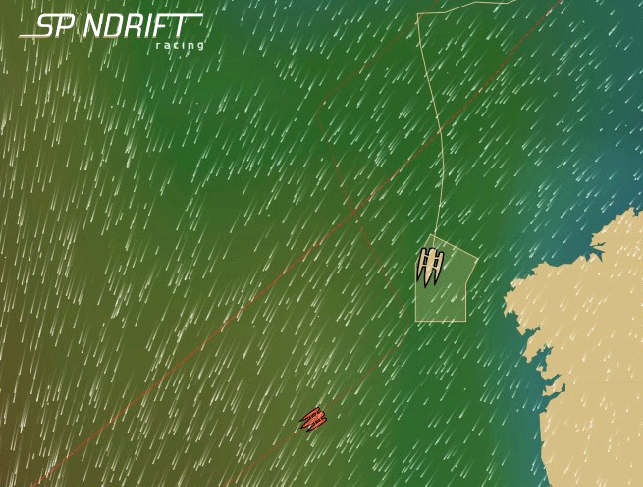
A Winner in the Brest Atlantiques
Just a dozen or so hours after Spindrift 2 started their record attempt, another journey was drawing to a close, as Franck Cammas, Charles Caudrelier and media man Yann Riou onboard the 105-ft trimaran Maxi Edmond de Rothschild were tacking upwind to the finish in light air off Brest to claim victory in the inaugural Brest Atlantiques, a 14,000-mile doublehanded race around the Atlantic that started nearly a month ago. Having pulled well clear of their rivals during their ascent of the Atlantic, the trio of Volvo Ocean Race winners made history not only in claiming victory in this inaugural race, but also in fully realizing the potential of the very first multihull designed from the ground up to fully foil across oceans.
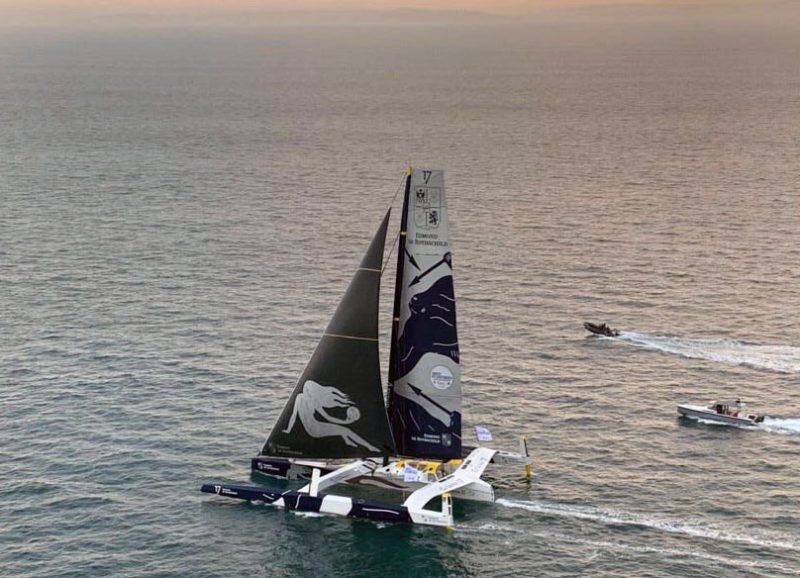
Behind the victorious trio, François Gabart and Gwenole Gahinet’s MACIF holds a narrow advantage over Yves le Blevec and Spaniard Alex Pella’s Actual Leader in the race for second place.
IDEC Sport’s Asian Tour
Half a world away from France, the very boat that holds the Trophée Jules Verne record now currently under attack, Francis Joyon and a crew of four onboard the 105-ft IDEC Sport have established another new reference time. IDEC Sport has sailed into Vietnam to establish a new record from Mauritius to Ho Chi Minh City in Vietnam, a highly unusual route. On a route of more than 4,000 miles across the Indian Ocean and South China Sea (more than 5,400 miles sailed), the five sailors took 12 days, 20 hours and 37 minutes to sail the course, which included highly complex and challenging light-air sailing through much of Malaysia and Indonesia.
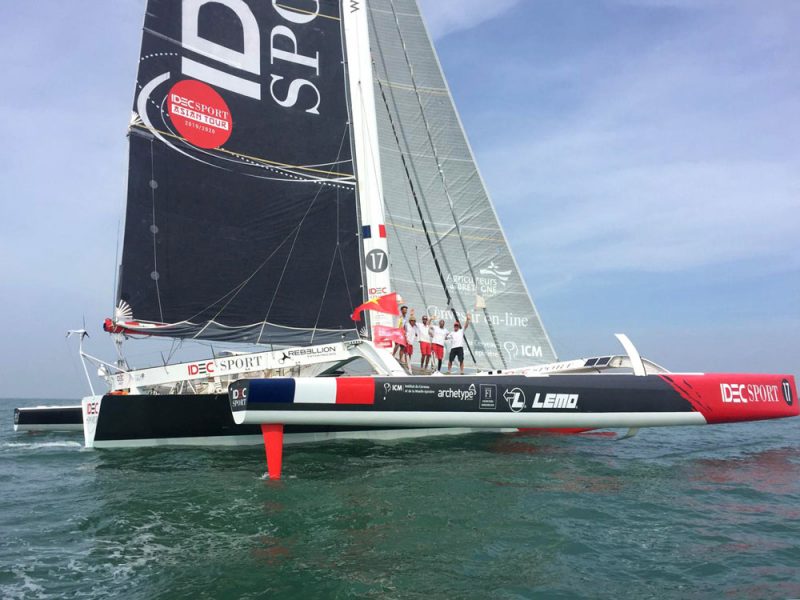
The record attempt was more of a delivery than anything, as the team is on its way to Hong Kong to attempt to break Giovanni Soldini and Maserati’s recently established China Tea Trade record from Hong Kong to London, which stands at just a bit over 36 days.
Special Pricing at Wayfarer Marina
A New Favorite Boat for Teenage Sailors
I don’t think I’ve ever been as excited about a new boat as I was when I heard about the RS Fevas. As a sailor for the Lowell High School sailing team at Golden Gate Yacht Club, I was more thrilled with the news that the club would be getting one of these new sailboats than I was when I heard that I would be getting my own C420. But could anyone blame me, who usually sails FJs and 420s, for being so excited over a fast, new, two-person dinghy with an asymmetrical spinnaker and an open back? This excitement only built when I saw the RS Fevas on the docks. I was told that on Saturday, November 9, I would be able to test them out for the first time. I spent weeks counting down the days until I’d get the chance to sail one. Once that day finally came, I savored every second of it. Instantaneously, the RS Feva became one of my favorite boats to sail.
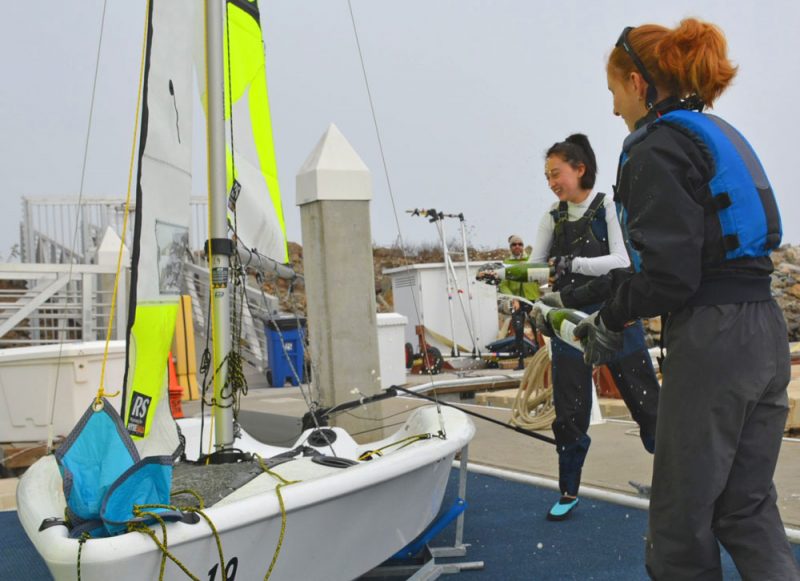
I hopped onto the boat with very little knowledge of how it operated and how it’s sailed. I was unable to participate in much of the rigging process due to getting an FJ ready for other sailors, and I had no previous experiences with the boat. Although the rig felt extremely different from what I was used to, skippering was about the same. Besides repeatedly hitting my crew with the long tiller, I had no issues driving the boat.
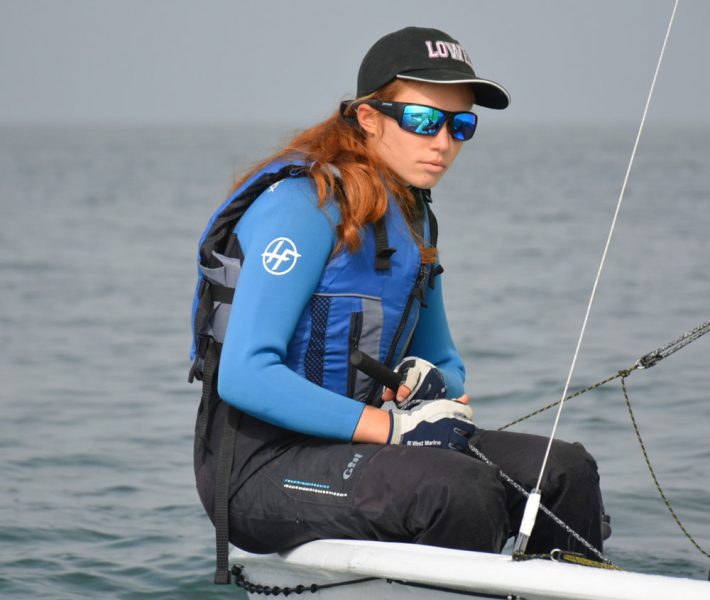
Conditions were extremely light, but this boat still managed to sail fast with the spinnaker downwind. In the channel, we found that it moved slower than we would’ve liked on the downwind, so we decided to take the jib down to give the spinnaker more air. The boat was able to move much faster with this change, although due to there being no place for the jib to go, it would sometimes drag in the water. It shouldn’t be required to make this change with more wind, but while sailing in the channel with less than 5 knots, it proved useful. Outside the channel, we had a fantastic experience with the spinnaker up. The boat moved extremely fast through the water, and it quickly became my favorite way of sailing it. Upwind, I found that the RS Feva could point much higher than an FJ but still not as high as a Laser, and I believe this could be advantageous while racing.
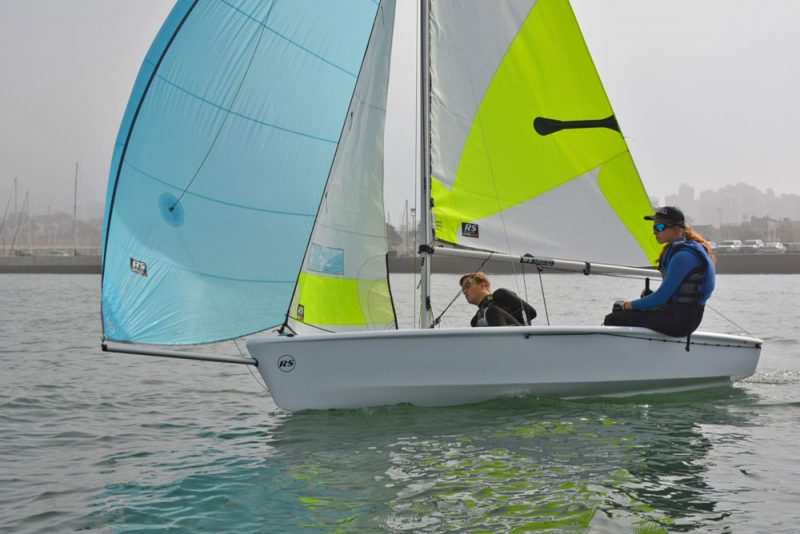
Although the boat is built for two people to operate it, I still decided to try to sail it on my own. And, to my surprise, it was not as hard to accomplish as I’d imagined. Due to the boat’s having jib cleats, I did not have to worry about holding the jib. I was able to keep my tiller extension and mainsheet in one hand while operating the spinnaker with the other. Jibes and tacks were extremely slow due to my having to switch over the jib and boom to the other side before I could resume sailing more appropriately, but I found the overall experience to be worth it. Sailing on my own provided me with more freedom, and I found it an exhilarating experience overall. Yet, because I had no prior knowledge of how to operate the boat, I found myself with no knowledge of how to take the spinnaker down, so I had to call someone over to explain it to me. Because of this, I do not know how difficult it would be to take the spinnaker down when sailing by oneself.
Later in the day, I decided to hop onto the boat again, but this time with two other sailors with me. I operated the mainsheet while one of us controlled the tiller, and the other managed the jib and spinnaker. Usually, two of us hiked while I trimmed the main from the leeward side, and I would only join them once we were moving fast enough for the boat to over-heel. This improper way to sail the Feva was still extremely fun due to the social aspect and the shared excitement when the sailboat was moving at its top speed in the given conditions.
Although during my sail I never capsized the boat, I did witness another Feva capsize. Due to its being lightweight, the skipper was able to bring it back up quickly. The weight is something I personally really enjoy about this boat because I usually have trouble bringing up 420s and FJs. The boat’s weight also makes it much easier to transport.
I believe that the RS Feva is going to become extremely popular once programs start running in the spring. Firstly, the boat will help Opti and Tera kids to transition to 29ers and later 49ers by providing them with the ability to learn fundamental spinnaker control as well as two-person communication, which is essential for more advanced boats. Secondly, the RS Fevas are easy to learn and fun to sail for those already familiar with more advanced sailboats. As a regular 420 sailor, I was able to learn the basics of operating the boat within two hours on my own due to its simplicity. The dinghy’s light weight allowed it to sail extremely fast even with very little wind, making it almost addictive instantaneously.
With the help of the Siebel Sailors Program, I can imagine that this boat will not only bring more kids to more advanced boats but also introduce more passionate kids to sailing. Either way, I’m ready to get back on the water in the spring, and I’m excited to see how the RS Feva will grow into the youth sailing community.


